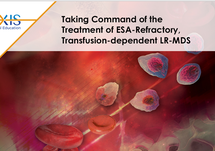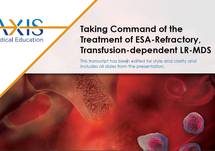Announcer Intro:
Welcome to CME on ReachMD. This activity, entitled “Taking Command of the Treatment of ESA-Refractory, Transfusion-dependent LR-MDS” is provided by AXIS Medical Education and is supported by an educational grant from Bristol-Myers Squibb Company.
Prior to beginning the activity, please be sure to review the faculty and commercial support disclosure statements as well as the learning objectives.
Here’s your host Dr. Paul Doghramji.
Dr. Doghramji:
This is CME on ReachMD, and I’m Dr. Paul Doghramji. I’m joined today by Dr. Rami Komrokji and PA Allan Platt to discuss ESA-refractory, low-risk MDS.
Dr. Komrokji:
Hello. It’s really pleasure to join you as well.
PA Platt:
Glad to be here.
Dr. Doghramji:
And we’re here to discuss ESA-refractory, low-risk MDS. So, let’s begin. PA Platt, to begin our session, can you first describe the diagnosis of anemia and when to refer a patient to a hematology specialist?
PA Platt:
Absolutely. It’s very common in primary care – 20% of your adult patients are anemic. Usually, that’s picked up on a routine CBC when you’re doing a physical exam. However, people can present with non-vertigo dizziness, weakness, fatigue – and those should all be indicated to check for anemia. On physical exam, you want to check their vital signs. If they’re unstable that person needs to go to a hospital base where they can be worked up and maybe even be typed and crossed for a blood transfusion, but if somebody’s stable, you can use peripheral tests to make pretty much 90% of the diagnosis. So, start with a CBC with a white cell differential. You’ll need a peripheral blood smear, you’ll definitely want a reticulocyte count that’s corrected, a metabolic profile, and a urinalysis. Based on that, it’s going to guide your whole work-up.
I have a flow chart that will guide you based on the results that you just obtained from those basic labs, and if you do see a low white count and either/or a low platelet count with anemia, that should be a pretty much referred to hematology immediately, something drawing at the bone marrow level. However, if that’s not present, you just have a pure anemia, you want to go on the reticulocyte count. Once it’s corrected, if it’s under 2, the bone marrow’s not producing. It’s a production problem. If it’s over 2, you’re losing blood either from bleeding or hemolysis, and there’s total work-ups for pursuing that. If it’s a low-production anemia, the next step is to look at your CBC and look at the size of the red cells. That’s MCV – mean corpuscular volume – microcytic, normocytic, or macrocytic, and each of those should have targeted tests to make the diagnosis.
For the microcytic chain, you want to look at iron studies primarily. Iron would be the most common, and basically, the ferritin level tells you what your storehouse iron is. You also want to consider electrophoresis looking for thalassemia, and a lead level looking for lead toxicity, and a c-reactive protein looking for inflammation. Those are the 4 big differentials for microcytic.
For normocytic, you’re going to look at your metabolic profile because kidney disease/liver disease are all big in this category with low EPO from the kidney if it’s renal failure. Get a TSH and a CRP looking for inflammation.
For macrocytic, you definitely want to do a B12 and a RBC folate level to check for B12 and folate deficiency. That’s going to be your most common in that category. If you can’t figure out with these peripheral tests, then basically you’re going to send your patient to hematology because the next step is a bone marrow biopsy if you can’t figure it out with the peripheral tests.
So, the microcytic differential – thalassemia, iron deficiency, chronic inflammation, and sideroblastic, rule-out lead toxicity first, but that may be MDS. For the normocytic side, if you can’t figure it out with the peripheral test, again, you’re referring to hematology. For the macrocytic, if it’s not B12 or folate deficiency you’re definitely going to send the patient to hematology, and their next step will be a bone marrow biopsy.
Hemolytic work-up – again that’s pretty much a hematology referral unless you have just G6PD deficiency, which would be picked up on a Heinz body stain, and that would be just removing the offending agent.
Dr. Doghramji:
Alright. Well, low-risk myelodysplastic syndrome, or LR-MDS, is an acquired bone marrow disorder that manifests with symptomatic anemia. Erythropoiesis- stimulating agents, or ESAs, are the first-line treatment, but not all patients with LR-MDS respond to ESAs, and many become refractory to ESAs. Dr. Komrokji, would you expand on the utility of ESAs and identification of ESA failure?
Dr. Komrokji:
Absolutely. Thank you. So, I think just to set the background to summarize the scope of the problem, myelodysplastic syndromes are the most common myeloid neoplasm we deal with. It’s one of the top 5 causes of anemia in elderly, as stated, and majority of the patients are actually what we call a lower-risk MDS, which means less likelihood to progress to acute myeloid leukemia. However, majority of those patients unfortunately will die from complications related to the disease, anemia, and its complications. Anemia is the most common cytopenia we encounter in lower-risk MDS. Almost 90% of the patients are anemic at time of diagnosis, and over time, more than half of the patients will become transfusion-dependent, needing blood transfusions every 2 weeks or sometimes more often. Isolated thrombocytopenia or neutropenia are less common to encounter. However, the coexistence sometimes dictate the choice of therapy. We have limited treatment options, and there is a huge unmet need for those patients. All the current available therapies we had in the past had roughly around 30% chance, and they work around probably a year or two.
When we look at patients with lower-risk MDS, actually most of them stay as lower-risk MDS. One-third of those patients may eventually progress to acute myeloid leukemia or higher-risk MDS, but when we look at the cause of mortality and morbidity, more than half of those patients, it’s directly related to the anemia and the manifestations of the cytopenia. The second most common cause of mortality and morbidity among lower-risk MDS patients are cardiovascular events, which probably also correlate with their anemia and the interplay between the anemia and the other comorbidities, particularly majority of MDS patients are in their 60’s and 70’s.
We also have looked at the severity of their anemia, and there’s correlation between the severity anemia and outcome obviously, but unfortunately, even patients that we label as moderate or severe anemia are undertreated in general, many of those patients just receiving blood transfusions or erythroid-stimulating agents.
Now, erythroid-stimulating agents are reasonable first step for management for the patients that are mostly anemic. There are different format of erythropoietin – short-acting, nowadays there are biosimilars, there is long-acting darbepoetin. It’s really a matter of dosing which ones to use. However, one could predict the chances of response easily by checking the endogenous serum EPO levels of those patients, and those patients that have less than 500, and some studies reserve to less than 200 endogenous serum EPO level, who are not heavily transfusion dependent, receiving less than 2 units every month, may have good chance of response. However, if a patient has endogenous serum EPO level more than 500, or they are receiving more than 2 units of blood every other week or monthly, then those patients have less than 10% chance of response. So, we typically recommend starting somewhere equivalent of 40 to 60,000 international unit of erythropoietin. This is different dosing than used in renal failure. We try that for somewhere around 6 to 8 weeks. If there is a response, we continue. If not, then we start thinking of moving to the next step. In general, around 40% of the patients will respond to erythroid-stimulating agents for a duration of a year, year and a half. There is around 40 to 50% of the patients what we call as primary resistance that will not have a response from the get going. Unfortunately, we see a lot of patients that had not had a good response to erythroid-stimulating agents, and they continue with that. In general, patients have to have either transfusion independency or an increase in their hemoglobin of and and a half grams that’s also seated with the improvement and the quality of life of patients to call that a response to erythroid-stimulating agents, but once they stop working, or if they do not work, then that’s usually an indication to start thinking of next treatment option.
We do have some options, and now our armamentarium had been expanded with newer therapies like luspatercept there is a drug approved called lenalidomide for patients with deletion 5q, luspatercept particularly for patients with ring sideroblasts, and also we use hypomethylating agents, azacitidine or decitabine, especially if patients have concomitant neutropenia or thrombocytopenia.
Dr. Doghramji:
Although advances have been made in the treatment of anemia in patients with MDS, there remains a significant unmet need for new and better treatment options for patients with ESA-refractory, transfusion-dependent MDS. One such option which you already mentioned is luspatercept. Would you discuss recent data related to luspatercept and its significance in the day-to-day management of ESA-refractory LR-MDS?
Dr. Komrokji:
Absolutely. Thank you again for the question. So, luspatercept was actually the first drug to be approved for MDS after almost a decade of not having any new therapies for MDS. Luspatercept is what we call erythroid maturating agents. Erythropoietin works on early steps of erythropoiesis, promoting early erythroid differentiation. However, luspatercept works on the terminal erythroid differentiation. It’s a fusion trap protein that neutralizes TGF-beta ligands, which turn to be a negative regulator of the terminal erythroid differentiation. So, this drug will release the terminal erythroid differentiation blockage that we encounter in MDS.
The drug was tested in 7 studies in phase 1/phase 2, and then in a large study called the MEDALIST where patients with lower-risk MDS with ring sideroblasts that were transfusion-dependent were randomized to receive luspatercept – it’s an injection given subcutaneously every 3 weeks – versus placebo, and the study met the primary endpoint where around one-third of the patients had sustained transfusion-independency with luspatercept, and that led to the approval of the drug. One of the major important predictors of response was really the magnitude of transfusion burden at the baseline. So, the less the transfusion burden was, the patients were more likely to response, and that those response rates could approach as high as 70%.
The treatment, in general, is well tolerated. As I mentioned, it’s an injection every 3 weeks. There was fatigue observed in patients, particularly during the first few cycles some GI toxicity, peripheral edema, but 95% of the patients were able to continue in treatment, no concerns of increased risk of AML transformation or transformation to higher risk.
So, based on the data from this MEDALIST study, the FDA approved luspatercept for patients after ESA failure, lower-risk MDS with ring sideroblasts.
Now, there had been updates on a longer-term follow-up on use of luspatercept. Dr. Pierre Fenaux presented that at the European Hematology Association in 2022 providing longer update and the data still remains encouraging when we look at patients that had sustained transfusion independence, which means 16 weeks or more. Around one-third of patients with luspatercept enjoyed that transfusion independency, and when we look at the cumulative duration of response, it almost approaches 80 weeks. So, those patients will stop needing blood transfusion, and there were some patients that needed some blood transfusions for different event such as bleeding, hospitalization, etc., but when we look at the cumulative duration of response, it’s almost approaching 81 or 82 weeks.
There were also some interesting data presented at the last American Society of Hematology meeting of longer-term follow-up and the impact of such treatments on overall survival and progression-free survival.
Dr. Santini from the Italian group, presented data on overall survival with luspatercept, demonstrating that responders enjoyed longer survival with the treatment. This also suggested that treatment of anemia is very important, and in the elimination of the anemia and transfusion dependency, could be an important factor in patients with lower risk.
In the same presentation it was demonstrated that patients that had lower-risk disease using as a classification system we use for the International Prognostic Scoring System, that those patients with very low risk had a survival advantage with the treatment.
Other that, I also had looked at the predictors of response and the dose dependent relationship. Dr. Platzbecker from the German group presented this data at the last American Society of Hematology meeting as well again demonstrating that patients that are not heavily transfusion-dependent suggesting that we should start those treatments earlier at the time of ESA failure, had higher responses. The other important point that a lot of patients will need dose escalation. Typically, we start with 1 milligram per kilogram subcutaneous injection every 3 weeks. After 2 doses, we go up to 1.33 and then up to 1.75.
So, there is a relation between the responses and the dosing. The low transfusion burden patients may respond to lower doses. However, the intermediate or high transfusion burden patients will often need higher doses to achieve the response.
So, now also we’ve shared our real-world data and experience after the approval of the drug. So, last year I also presented myself data on real-world experience with almost 114 patients treated with luspatercept, which was unique to this that I think to the patients that had prior therapies, such as hypomethylating agents or lenalidomide, which was not part of the MEDALIST study, and indeed, we saw responses very similar to what was reported in the MEDALIST study, around 40% of the patients responding, transfusion burden being the most important predictor of response needing to escalate the dosing, and we also observed that the responses were seen after exposure to hypomethylating agents and lenalidomide. However, those patients after hypomethylating agents failure or lenalidomide failure tend to have higher burden of their disease.
Dr. Mukherjee also presented data from real-world experience in the same meeting, again, showing the same data that patients that are low transfusion burden will have a very high chance of response in the real world. Patients that are high transfusion-dependent will most often need the highest dose of the luspatercept. However, both sets of data from real world were actually showing that the same responses observed in the MEDALIST were observed in real-world experience.
Our group also had been interested looking in combining luspatercept with erythroid-stimulating agents. So, as we said, erythroid-stimulating agents work on early stage, while the luspatercept works on the later stage of erythropoiesis, so it makes sense to combine them. So, we took patients that had ESA failure, had luspatercept treatment and had luspatercept failure, and we combined them, and, indeed, in around one-third of the patients, we observed that we can gain the response, suggesting there is some synergistic or additive activity having the combination, and that’s now subject of several trials.
So, a lot of improvement and in this treatment option, a longer follow-up data demonstrating that the MEDALIST results were duplicated in real life, and this provides a new option for our patients with lower-risk MDS.
Dr. Komrokji:
The landscape for management of myelodysplastic syndromes, however, I think, they simply will be changing based on data presented at both ASCO 2023 and EHA 2023 meetings. Those mostly you know, are in the lower risk MDS. There were two studies presented, at those meetings. The COMMANDS study with luspatercept, where the have just got published in the Lancet, Journal, and the IMerge study addressing role of imetelstat in lower risk MDS.
So, I’ll provide a brief overview of those trials, starting with the luspatercept. This was the COMMANDS study where luspatercept was compared to epoetin alfa for treatment of anemia in erythroid-stimulating, agent-naïve, lower risk MDS patients requiring blood transfusions. This study was presented at both ASCO and EHA meetings this year. And the study included lower risk MDS patients that were transfusion-dependent, between two to six units of blood every eight weeks, and no prior ESA treatment. And patients were randomized between receiving luspatercept similar to the dose administered in the MEDALIST trial, or erythropoietin. The primary endpoint was a robust red blood cell transfusion independence for 12 weeks or more, as well as a hemoglobin increase more than 1.5 grams per deciliter. But we also assessed other endpoints, such as durability of transfusion independency for 24 weeks or more,the duration of the transfusion independency, the safety, the disease progression.
So the study included 178 patients in the luspatercept arm, and similar on the erythropoietin arm. The two arms were well-balanced.A majority of the patients were receiving less than four units of blood.The study was enriched by, ring sideroblast patients, or SF3B1-mutant, patients where almost, two-thirds of the patients were RS positive, and 60%, were, ring sid – or SF3B1 mutant.This is expected because there is some physician bias on the trial, and that subset of patients with MDS, have a favorable outcome so those patients become prevalent in practice.
The study met the primary endpoint, in the intent-to-treat analysis.The responses were doubled – almost 59% with luspatercept compared to 31%, with erythroid-stimulating agents. when we looked at subsets, the luspatercept did better than ESA in most of the subsets.Of note, particularly in patients with endogenous serum epoetin between 200-500, the, response to erythroid-stimulating agents was 12% versus 41%.
Dr. Doghramji:
PA Platt and Dr. Komrokji, thank you for reviewing this data, and exciting data, with us today. So, I want to thank our audience for listening in, and thank you, Dr. Komrokji and PA Platt, for joining me and sharing all of your valuable insights. It was great speaking with you today.
Dr. Komrokji:
Thank you. It was my pleasure, and hopefully the audience will find this helpful.
PA Platt:
Thank you very much, too, for having us.
Announcer Close:
You have been listening to CME on ReachMD. This activity is provided by AXIS Medical Education and is supported by an educational grant from Bristol-Myers Squibb Company.
To receive your free CME credit, or to download this activity, go to ReachMD.com/CME. Thank you for listening.




















Facebook Comments